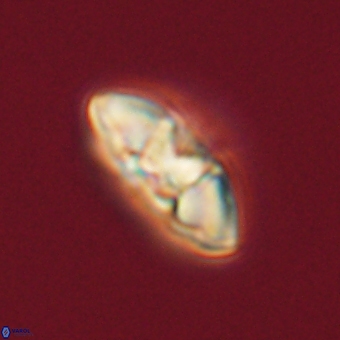Carlamuelleria karacuhae
Carlamuelleria karacuhae Varol, 2023
Large (8.0–11.0 μm) species of Carlamuelleria, possessing a non-birefringent subcircular distal shield, a vestigial diminutive proximal shield and an elliptical birefringent tube cycle.
In honour of Emin Karaçuha, a geologist, Izmir, Turkey.
Length of the shield: 9.62 μm, the width of the distal shield: 9.02 μm, length of the tube cycle: 3.14 μm, the width of the tube cycle: 2.84 μm, the maximum thickness of the distal shield: 3.75 μm (all measured in phase-contrast).
The distal shield is lenticular, has a shallow depression on its less convex side, and consists of between 24 and 36 segments. The tube cycle and vestigial diminutive proximal shield combination creates a brandy goblet-shaped structure in side view. In plan view, the tube cycle is elliptical, with a width less than that of the shield.
It is difficult to determine the direction of curvature of the parallel extinction lines to identify which side the species lies on. With the gypsum plate inserted, when the length of the species is aligned in a north-south direction, the tube cycle shows blue regions aligned in the NW-SE direction (Plate 5, Figs. 10, 12 in Varol, 2023) on both the proximal and distal sides. The blue sectors of the tube cycle and shield are aligned in opposite directions. The entire species appears birefringent in side view.
Carlamuelleria karacuhae is easily differentiated from other species of Carlamuelleria by having a subcircular distal shield and an elliptical tube cycle. It is often challenging to distinguish Carlamuelleria karacuhae from the subcircular species of Markalius astroporus in plan view. In cross-polarised light with a gypsum plate, Carlamuelleria karacuhae differs from Markalius by showing diagonal interference colours, whereas the latter species shows axial interference colours. The interference patterns in the tube cycle and the shield are in opposite directions in both species. Carlamuelleria karacuhae is consistently and confidently identified from the subcircular species Markalius astroporus in side view on a mobile mount. Markalius astroporus has a spaced proximal shield with an acute inclination angle, whereas Carlamuelleria karacuhae has a vestigial, diminutive proximal shield.
Varol, O. 2023. New paleocene calcareous nannofossils: Carlamuelleria, Davidbukrya, Mauriceblackia, Noelia and Senelia. Marine Micropaleontology. 180: 1-41.



